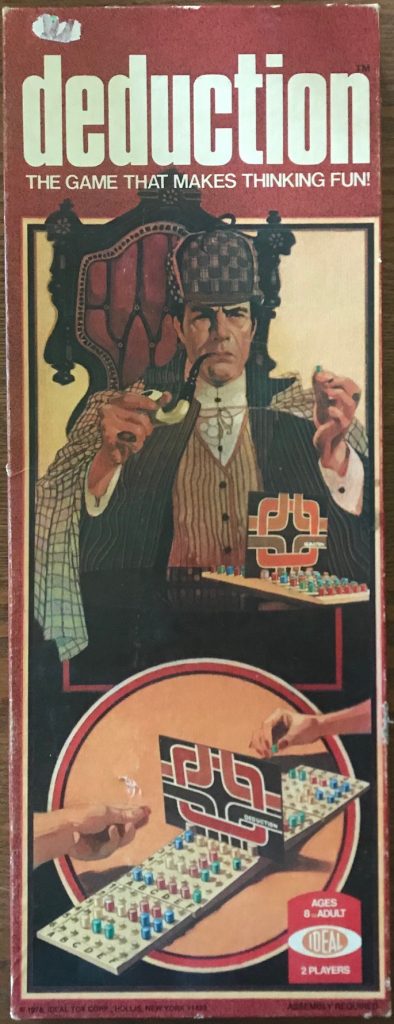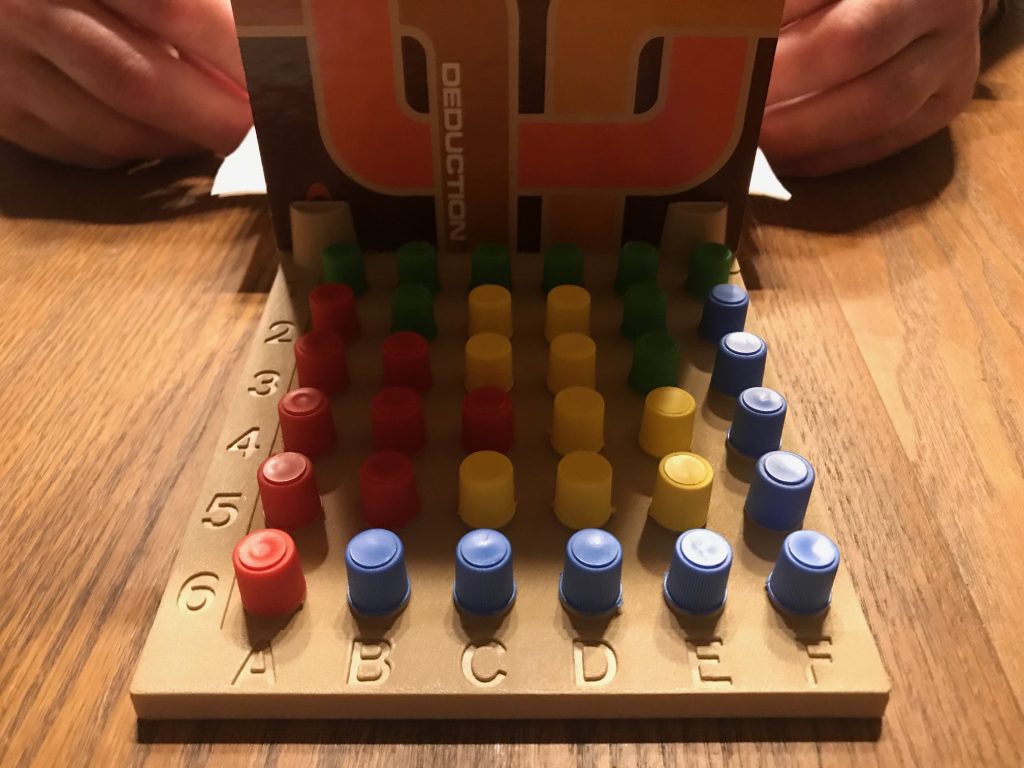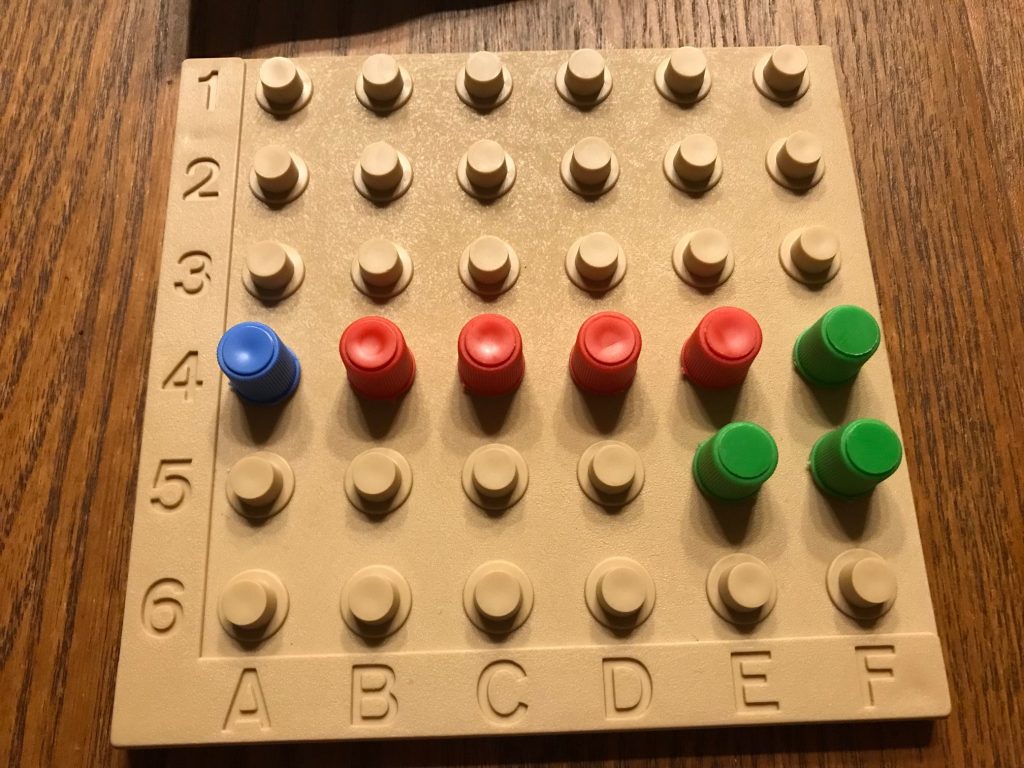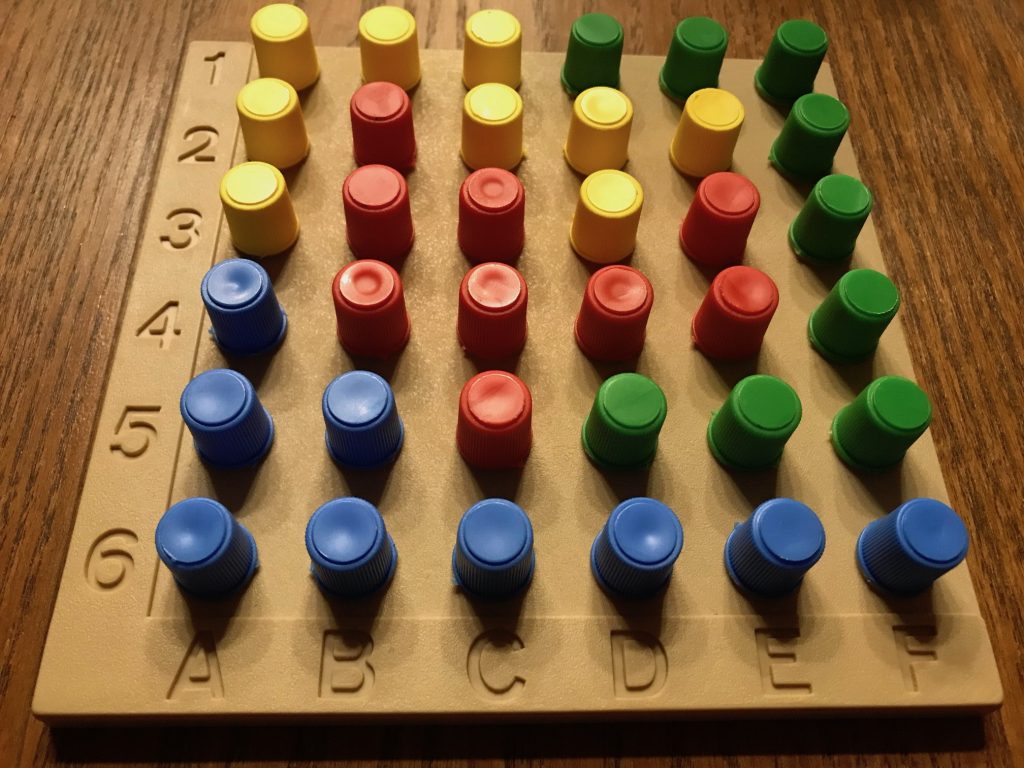Review: deduction
Publisher: Ideal
Year: 1976
Tagline: THE GAME THAT MAKES THINKING FUN!

how we met
When I can’t remember where I bought a game, I like to try and explain why I would have purchased that particular game. I know that I got deduction at a thrift shop because it still has the $1.99 sticker on it. But I don’t really remember when or where. So let’s talk about why.
The box is tall (20.5” to be exact) and awkward. The art is oh-so 70’s. Deduction is clearly a thinking person’s game, and Ideal rarely steers me wrong. I was seduced by the cover and ready to deduce the patterns.
how it plays
Each player gets 36 pegs, made up of nine pegs in each of four different colors. Each player has a PATTERN BOARD that is hidden from the other player’s view by a Divider Screen. The PATTERN BOARD has numbers along the left side and letters along the bottom. Then each player makes a pattern on their board with their pegs. In my opinion, the easiest thing to do is put all your pegs into the PATTERN BOARD and then arrange them. This hides your movement a bit better.
You can place your pegs on your PATTERN BOARD anywhere you want, with just a single rule. Pegs of a given color must be touching at least one other peg of the same color, either vertically or horizontally (not diagonally).
Once both players are ready with their patterns, gameplay can start. Each player has a DEDUCTION BOARD in front of them that will help them rebuild their opponent’s pattern.

On a player’s turn they have a couple of options.
- They can ask for a peg using a location. For example, Player 1 can say, “Can you give me A4?” Then the opponent Player 2 takes the peg in their A4 location and gives it to Player 1, who places it in the A4 location of their DEDUCTION BOARD. That ends Player 1’s turn.
- They can declare what a peg is from having deduced it through other gameplay. For example, Player 2 can say, “D2 is blue.”
- If Player 2 is correct, Player 1 hands over their blue peg in D2 and Player 2 may continue play either declaring a peg or asking for one. Asking for one always ends that player’s turn.
- If Player 2 is incorrect, no pegs change hands and the turn ends. But Player 2 needs to remember what they asked, as that information is still helping deduce the correct peg.
The goal is to slowly recreate your opponent’s PATTERN BOARD in your own DEDUCTION BOARD using their pegs as you guess them or ask for them. The first player to successfully gain their opponent’s last peg wins deduction!
how it went
Bill and I played deduction a couple of times in the last couple of weeks. I do love deduction games, and I love how [this game] deduction boils this genre down to the very basic elements.
Since we played at our dining room table, we both covered our PATTERN BOARDs with napkins. That made me more comfortable. The Divider Screen was fine, but we could move more freely by simply keeping something over our pattern and not worrying so much about our eyes straying.
I enjoy taking my early turns requesting fairly random pegs. If I find the beginning of a pattern that’s great, but I learn the most if I can jump straight to the end of that pattern and leave room for deduction in the middle. I had a couple of lucky guesses in our first play that let me clear out several pegs at a time.

You know that there are nine pegs in each color, and you know that they all have to touch. In our patterns, I would occasionally get presented with points that could have been either of two possibilities. And you should think about this when you plan out your own pattern. There were a few occasions when a point could have been any of three or, less often, four different colors! That almost forces me to ask for the peg and give up the ability to continue that turn with my mad deduction skills.

I was winning [this game] deduction for most of our first game, but Bill pulled out the win in the end. If it had gotten to my turn, I had it, but Bill won [this game] deduction!
play or pass
Play. If you are interested in a quick deduction game that does not require an app or several players, [this game] deduction has you covered. As I mention above, [this game] deduction boils the genre down to its basics. If you truly love the deduction genre, then [this game] deduction should not disappoint.
It’s probably worth mentioning that many of the BGG ratings note people’s fond memories of [this game] deduction from their youth, and that they are now enjoying playing the game with their kids. So if you have kiddos around you that is perhaps another reason for interest in [this game] deduction.